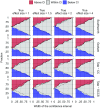Empirical confidence interval calibration for population-level effect estimation studies in observational healthcare data
- PMID: 29531023
- PMCID: PMC5856503
- DOI: 10.1073/pnas.1708282114
Empirical confidence interval calibration for population-level effect estimation studies in observational healthcare data
Abstract
Observational healthcare data, such as electronic health records and administrative claims, offer potential to estimate effects of medical products at scale. Observational studies have often been found to be nonreproducible, however, generating conflicting results even when using the same database to answer the same question. One source of discrepancies is error, both random caused by sampling variability and systematic (for example, because of confounding, selection bias, and measurement error). Only random error is typically quantified but converges to zero as databases become larger, whereas systematic error persists independent from sample size and therefore, increases in relative importance. Negative controls are exposure-outcome pairs, where one believes no causal effect exists; they can be used to detect multiple sources of systematic error, but interpreting their results is not always straightforward. Previously, we have shown that an empirical null distribution can be derived from a sample of negative controls and used to calibrate P values, accounting for both random and systematic error. Here, we extend this work to calibration of confidence intervals (CIs). CIs require positive controls, which we synthesize by modifying negative controls. We show that our CI calibration restores nominal characteristics, such as 95% coverage of the true effect size by the 95% CI. We furthermore show that CI calibration reduces disagreement in replications of two pairs of conflicting observational studies: one related to dabigatran, warfarin, and gastrointestinal bleeding and one related to selective serotonin reuptake inhibitors and upper gastrointestinal bleeding. We recommend CI calibration to improve reproducibility of observational studies.
Keywords: calibration; observational studies; systematic error.
Conflict of interest statement
Conflict of interest statement: M.J.S. and P.B.R. are full-time employees and shareholders of Janssen Research & Development.
Figures







